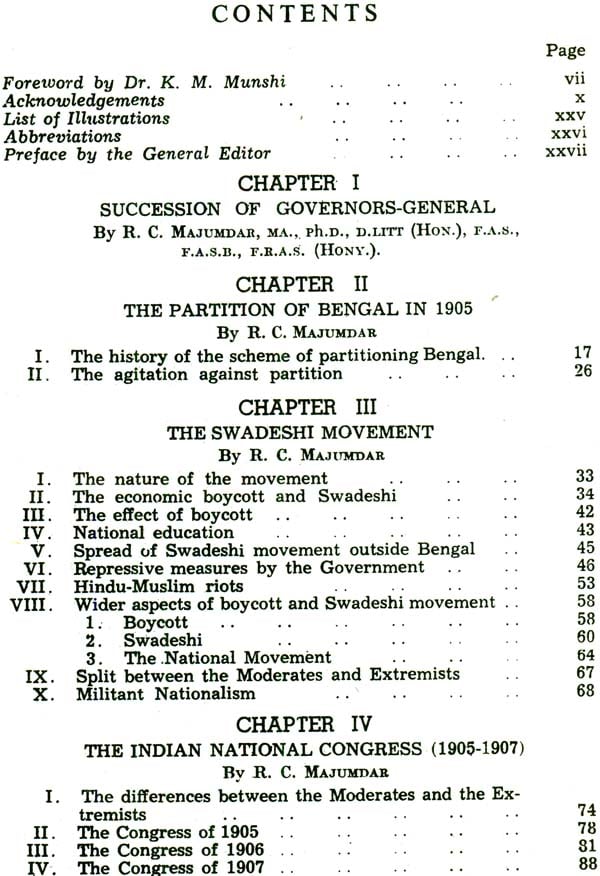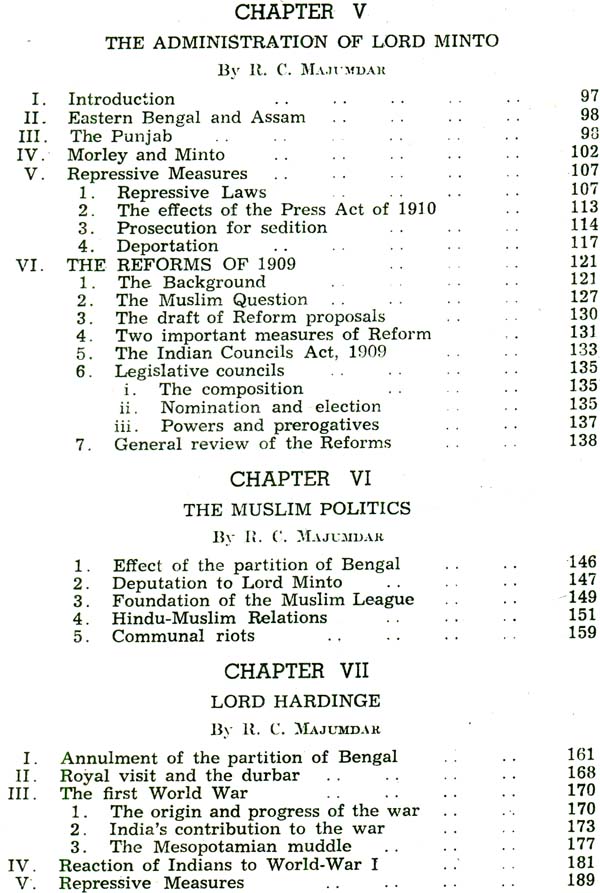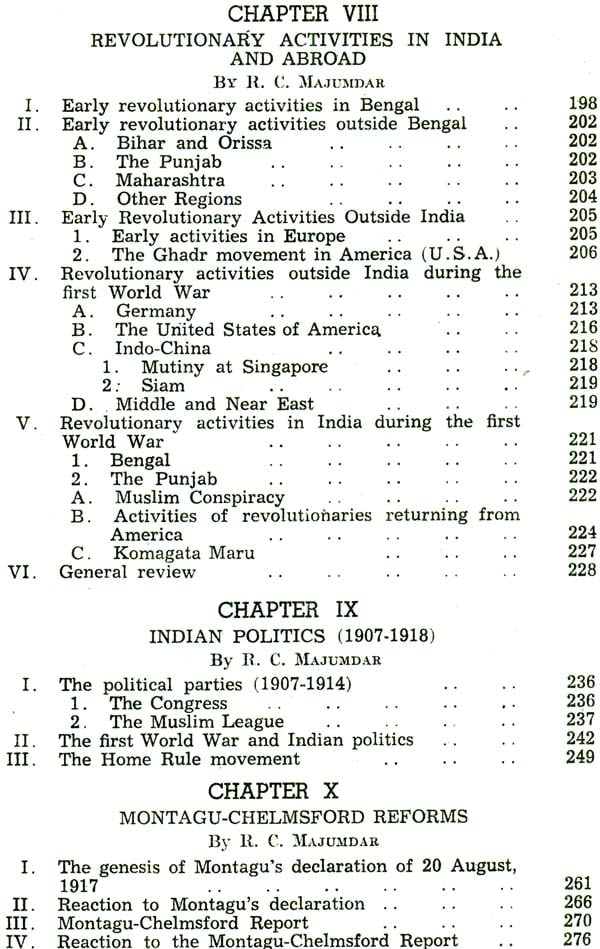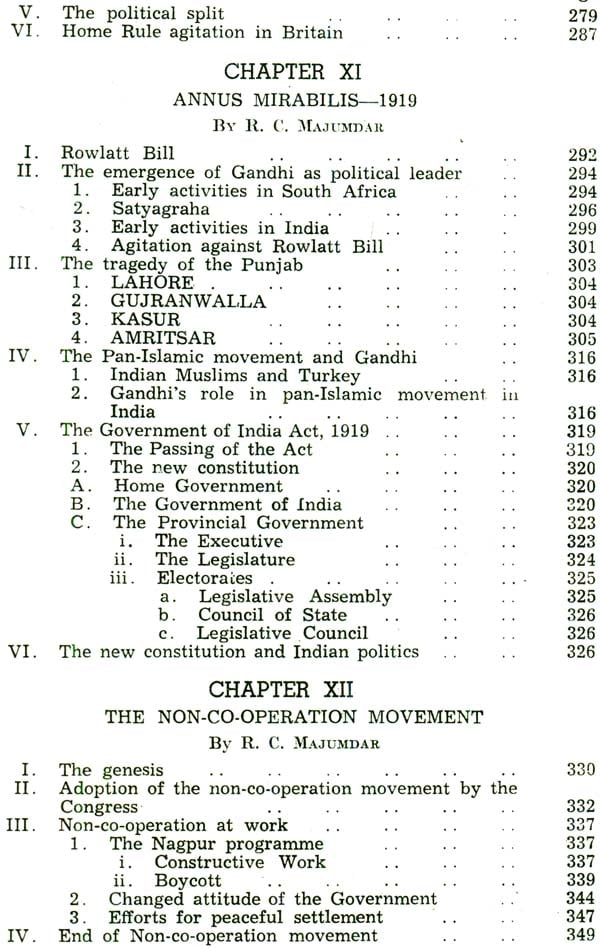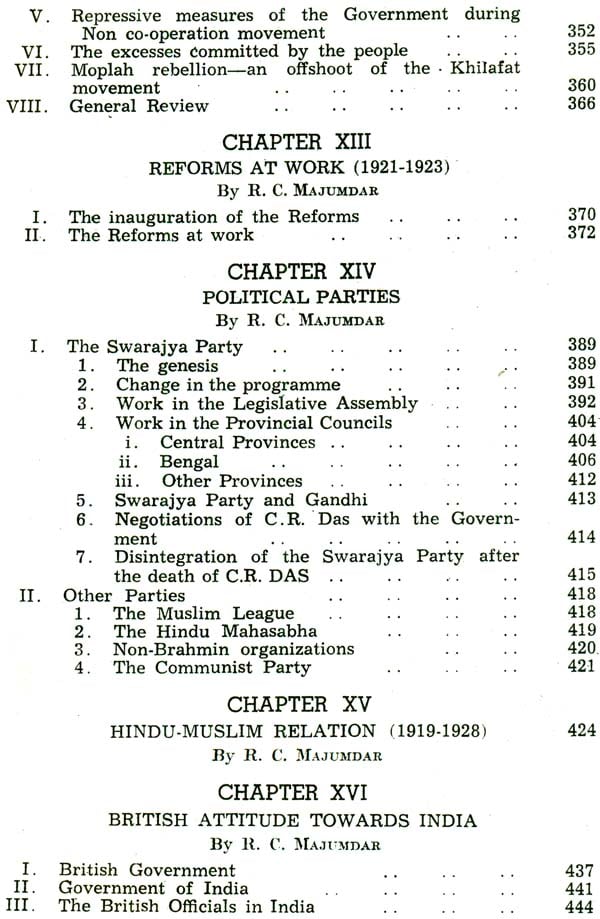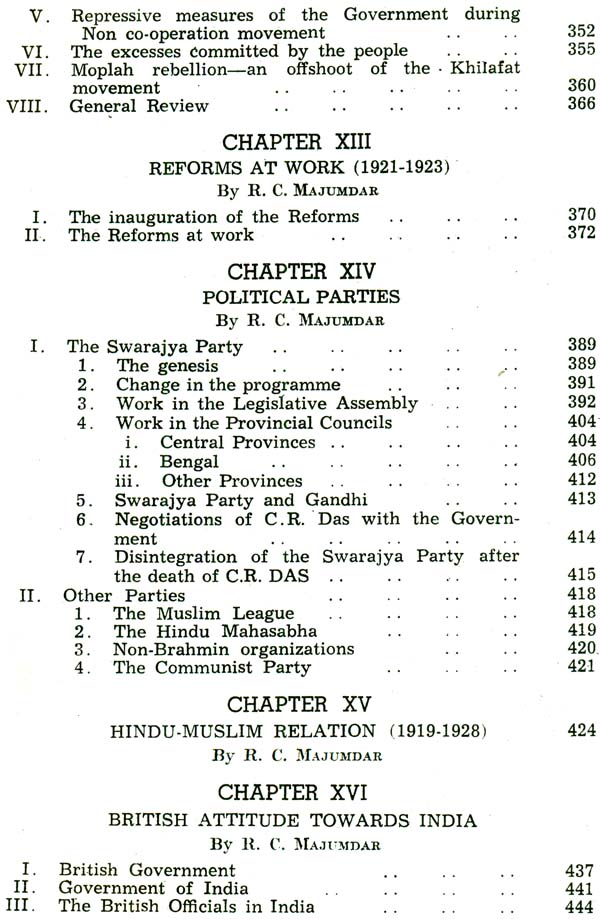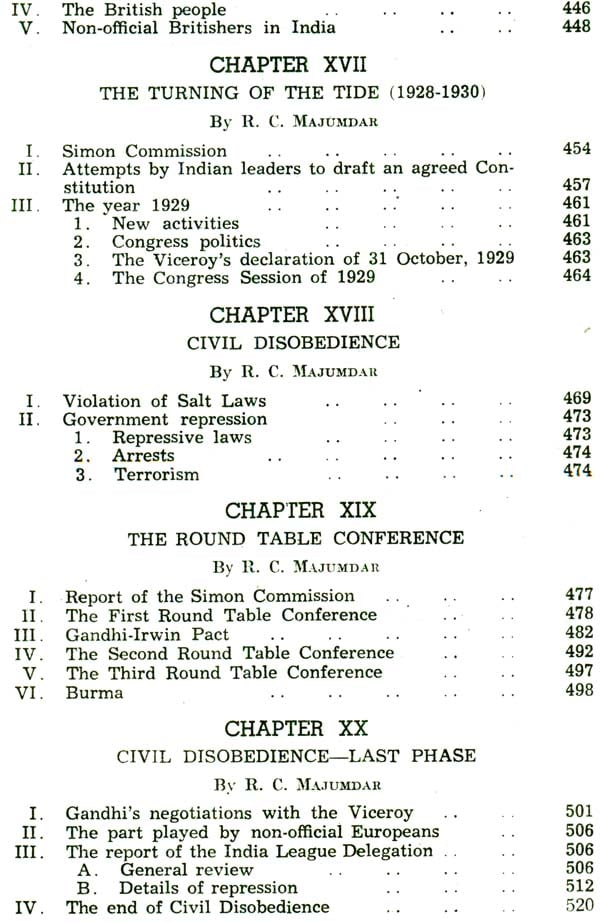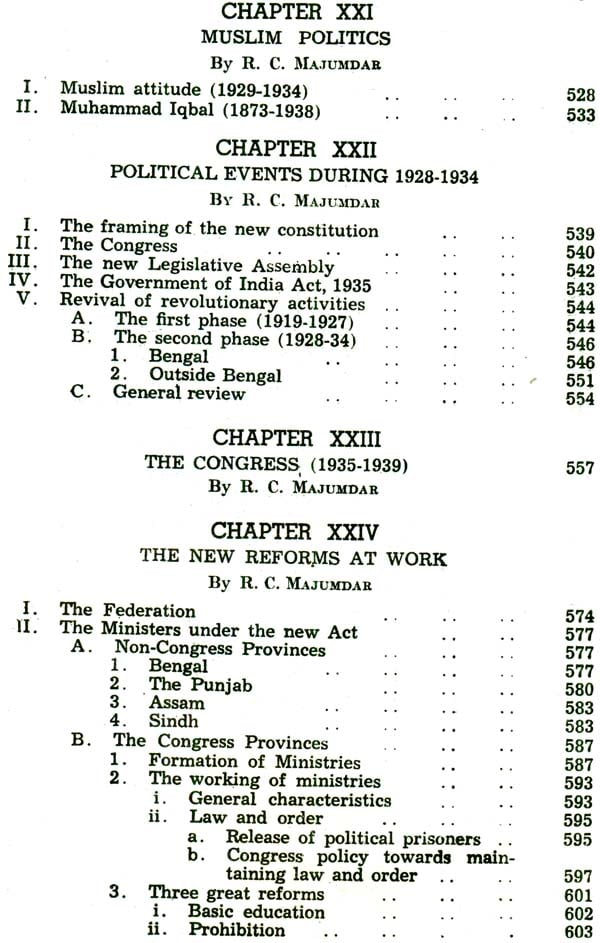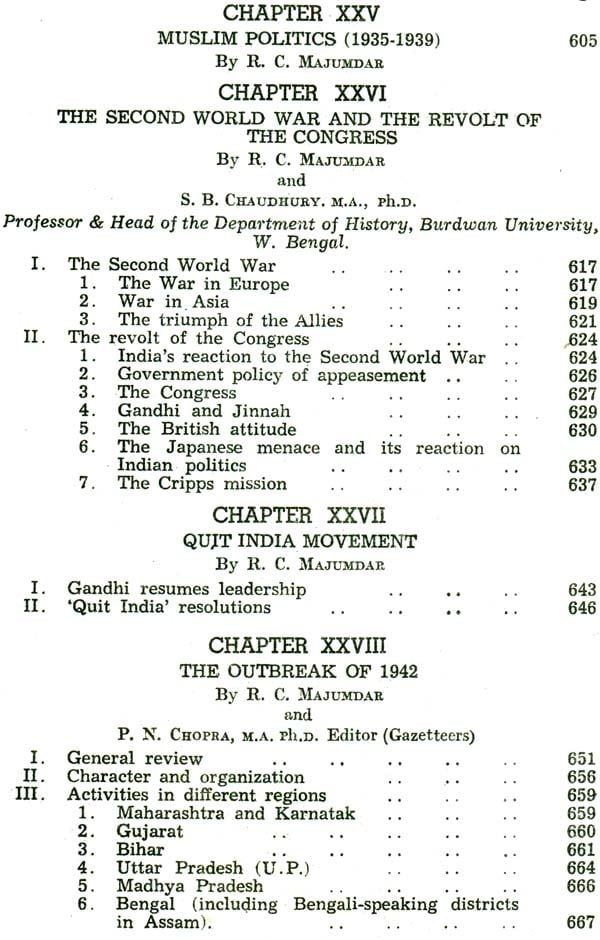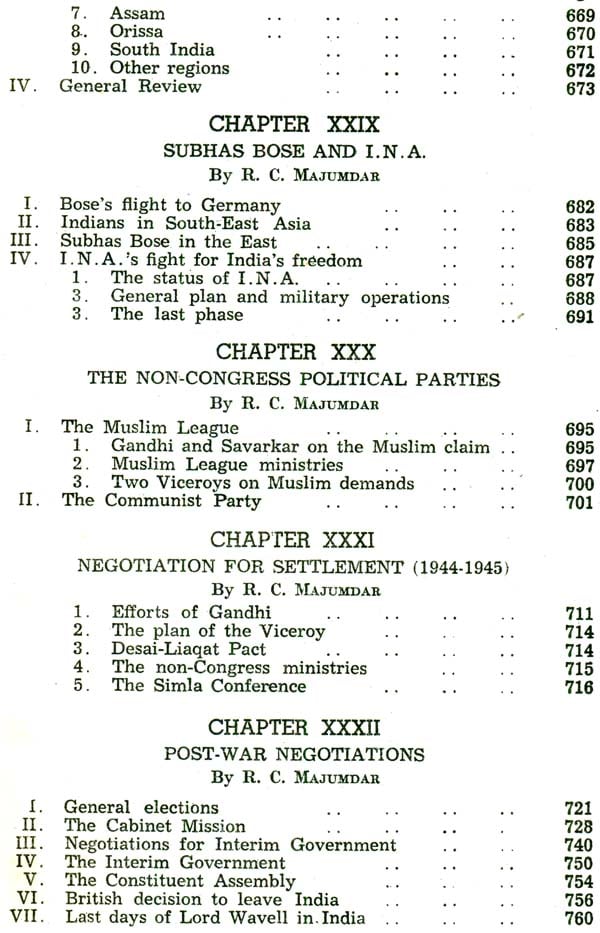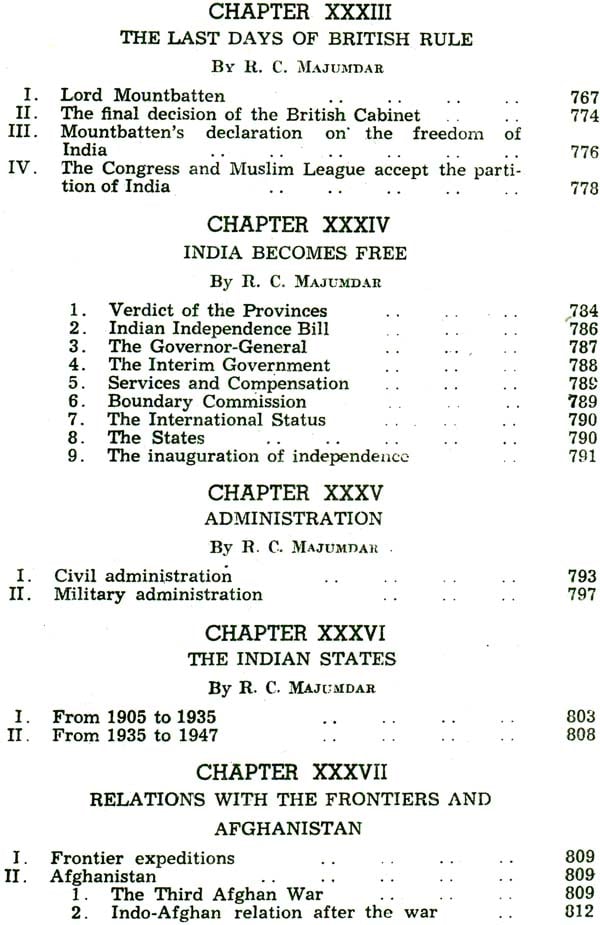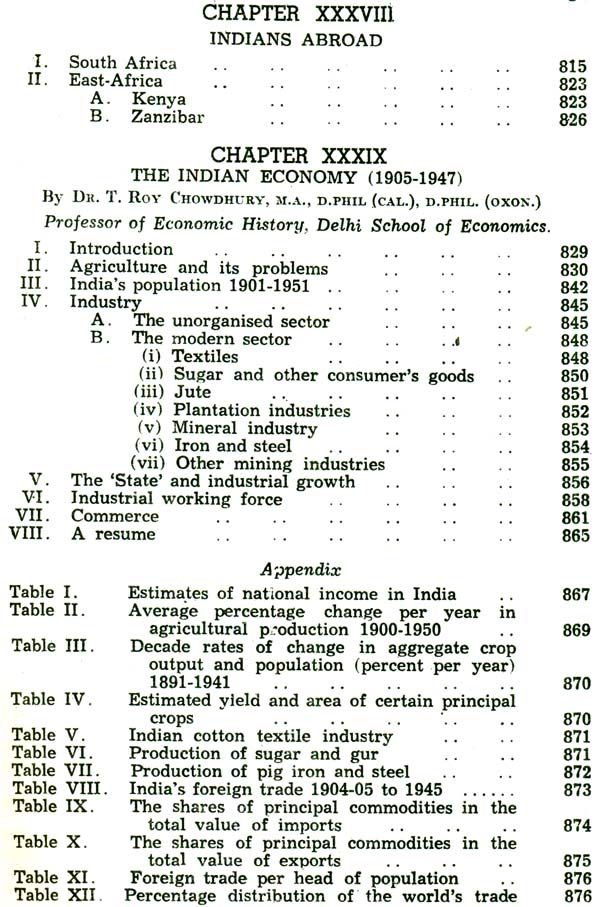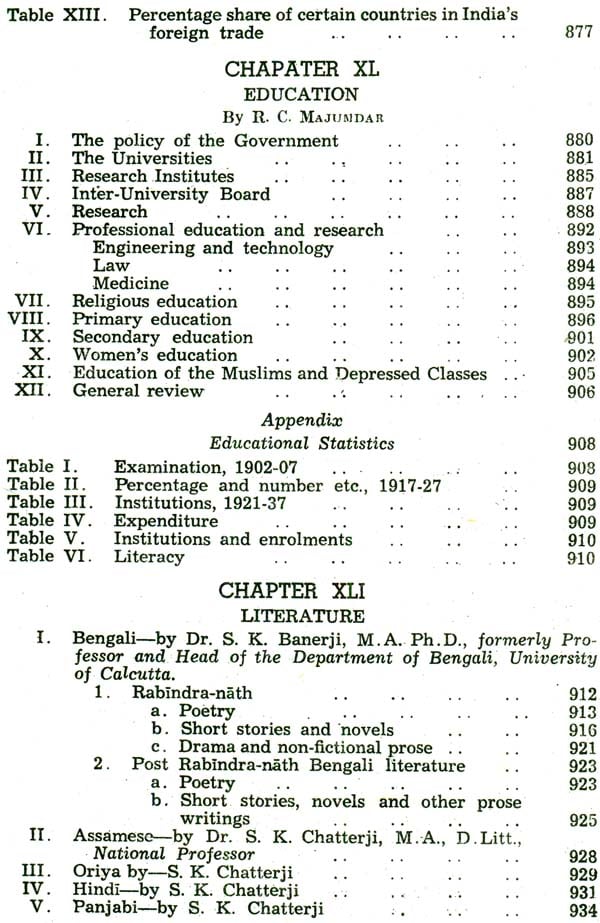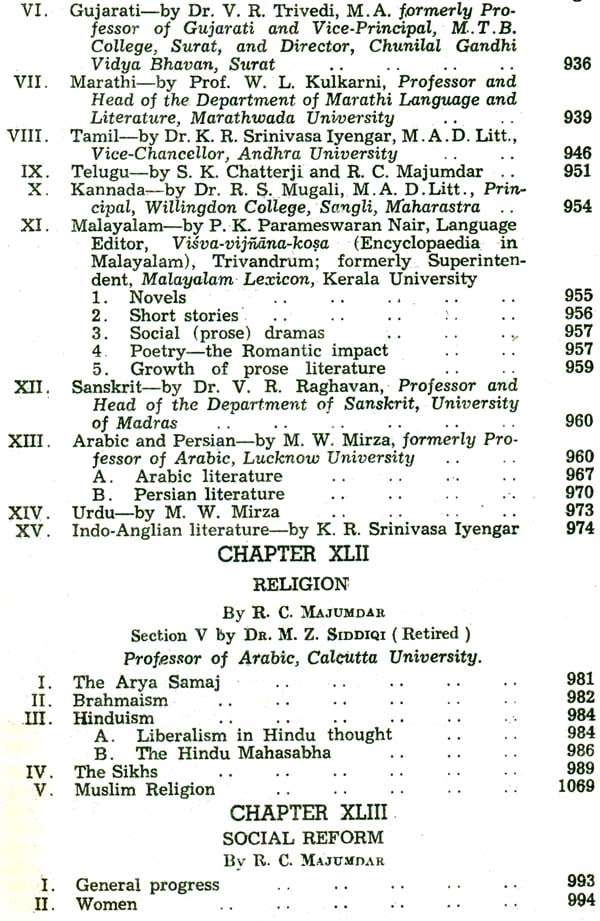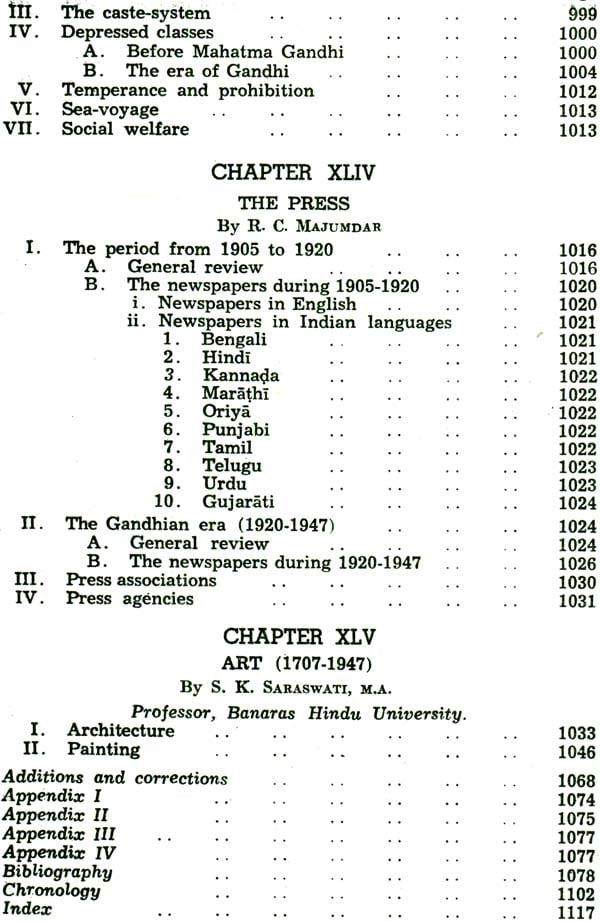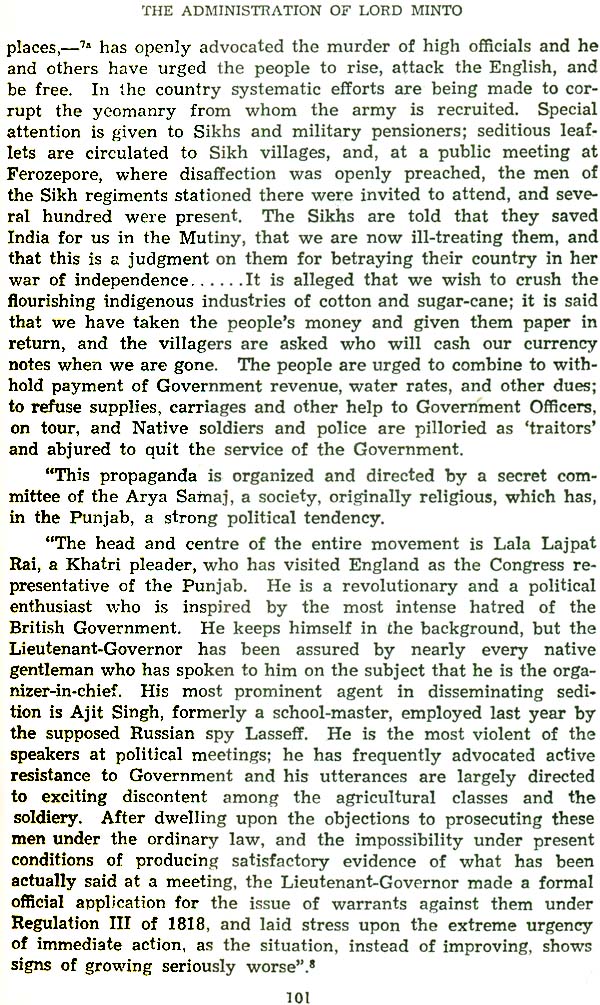
Struggle for Freedom : The History and Culture of the Indian People (Volume XI)
Book Specification
| Item Code: | NAI200 |
| Author: | R.C. Majumdar |
| Publisher: | Bharatiya Vidya Bhavan |
| Language: | English |
| Edition: | 2022 |
| ISBN: | 9788193867938 |
| Pages: | 1176 (18 B/W Illustrations) |
| Cover: | Hardcover |
| Other Details | 9.5 inch x 6.5 inch |
| Weight | 1.80 kg |
Book Description
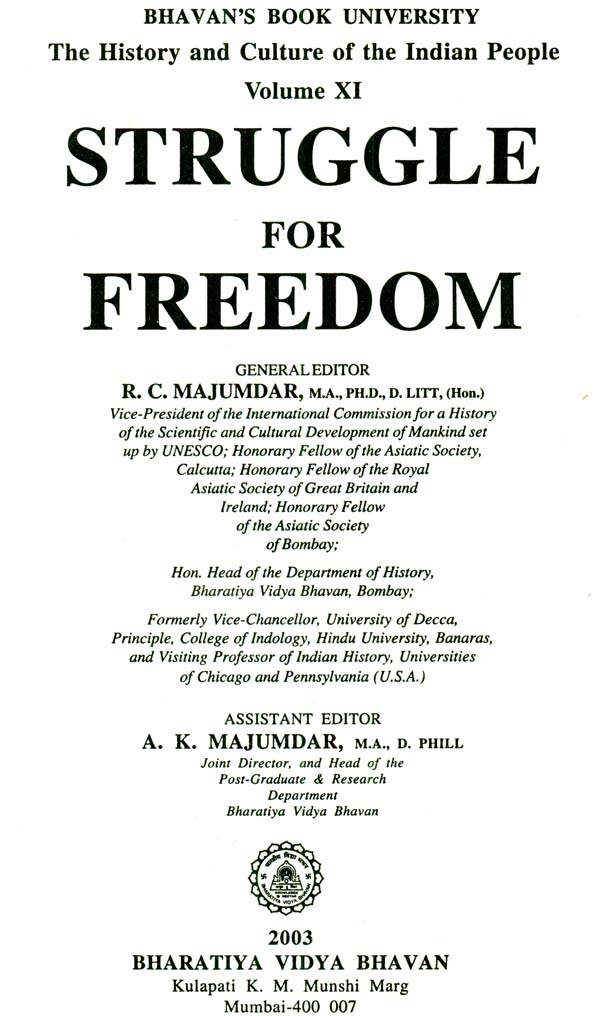
Foreword
The publication of this volume is to me the near-realization of a long-cherished ambition of preparing and publishing a comprehensive history and culture of the Indian people by Indians. Many years ago, in defining the scope of history, I ventured to suggest that it must be primarily the/story of the people of the land, a progressive record of their life and achievements in which their exploits and traditions serve as the pillars on which the super-structure of history is built to elucidate the characteristic reaction of the people to political, social and economic changes.
Thus, history includes the story of political changes and vicissitudes which create the forces and conditions operating upon life, social institutions and beliefs; they provide the norms, creative arts and movements of thought which go to create values. To all these, people react, forging a collective will in a bid to form an organic unity. The central purpose of history, therefore, must be to investigate and unfold the values, which in succeeding ages have inspired men to develop their collective win and to express it through the manifold activities of life.
Whether my ambition has been realized is for the readers to judge. However, the writing of the history of India, particularly the earlier period, is beset with difficulties. For, while the history of religion and philosophy from the Vedas down to our times is well documented, that of political history is scattered and hardly adequate to be shaped into a continuous narrative. An important fact, however, emerges from this strange contrast: whatever the. political vicissitudes, be they internecine wars or foreign invasion, our' sages, seers, and poets went on undisturbed in their quest or unity-social, cultural and spiritual. Even in the present century when political thought and scientific approach dominate the destiny of man, the great names of Indian history are those of Rimakrishna Paramahamsa, Vivekananda, Sri Aurobindo, Ramana Maharshi, Dayananda Saraswati, Rabindranath Tagore and Mahatma Gandhi. This is a fact of history which the present genertion may carefully bear in mind. For, there is the danger, that the science and methodology of history, as developed in the West, being based upon the Graeco-Roman history and that of Europe in the middle and modern ages, may' bypass special features and accomplishments of Indian history, when it differs from the established notion, as irrelevant or obscurantist.
Another problem that we have to consider is the persistent demand for the rewriting of history to foster communal unity. To my mind, nothing can be a greater mistake. History, in order to generate faith in it, must be written as the available records testify, without any effort to exaggerate or minimise the actual facts. Suppression and distortion of evidence, leading to false conclusions about the past, is hardly the way to improve the present situation or build up a better future.
I have had the privilege of living through the period of history covered by this volume, and practically from 1915 onwards I took part, small though it was, in the various nationalist struggles which I have described in my book Pilgrimage to Freedom. I shall not therefore go into those facts here. But one point I want to make clear. The communal problem, which ultimately divided the country, was neither inevitable nor insoluble. It was a price we had to pay for our inability to assess political realities.
Recent events in Pakistan have shown that religious bonds like Islam are not sufficient to create a nation out of different people separated by deep cultural traditions and language, and living more than a thousand miles apart. Indeed, Pakistan was created to placate not so much the Muslims, fifty millions of whom were left in India, but Mr. Mohamed All Jinnah who wanted a kingdom for himself. 'I knew Mr. Jinnah very well, being his close associate in the Home Rule Movement. He was inflexible, indomitable and honest according to his own light but was totally incapable of understanding other's point of view. However, Pakistan was created in his shadow and once he disappeared the political stability was in jeopardy.
In India, the greatest danger is the formation of sub-nation States and linguistic chauvinism. The formation of homogeneous provinces on the basis of language was an administrative necessity, and was recommended by the Congress long before anyone dreamt of independence in 1947. After independence some necessary adjustments were made, but it is impossible to draw the boundaries of a State in such a manner as to totally exclude linguistic groups from the adjacent States. Nor is such a boundary necessary or desirable, for we are citizens of India, not of any State, though the present dangerous trend is to identify oneself with his State rather than with India.
This tendency was not' apparent before independence; it· may be a passing phase. But, while it lasts, it has to be dealt with firmly though sympathetically, without weakening the Centre or the federal bonds in any way . It has been the experience of history, as the pages of preceding volumes of this Series testify, that this subcontinent has fallen a prey to foreign invasion in' the absence of a strong central authority. This lesson of history we had in mind when we adopted a quasi-federal constitution for India. What is now needed is not a constitutional change but a psychological one with political realism.
Unity of India is not a modern exotic growth, but is as a French scholar has put it recently. a response, 'a des liens ancients et profonds de conceptions, de sentiments, de rapports de situations, entredes groupes infiniment disparates, mais entes sur un meme fends'.
Before I conclude, I would like to repeat that the publication of 9 out of the 11 volumes of the Bhavan's History Series has been a matter of immense joy and pride to me.
I am deeply grateful to Dr. R. C. Majumdar whose tireless industry "and profound knowledge of Indian history ensured the success of this undertaking. I am also. indebted to all the learned contributors to the volumes, some of whom, alas, are no longe alive to share with us the joy of a great achievement. I should not forget to pay. a special tribute to Dr. A. D. Pusalkar, whose scholarship and diligent co-operation were available to Dr. R. C. Majumdar in full measure till the completion of five volumes. Dr. Pusalkar's .place had been taken by Dr. A. K. Majumdar, whose energy and sound knowledge have been of great value to his father.
I offer my thanks to the donors who have extended generous financial assistance by way of grant or loan to the scheme. I am also thankful to the Government of India for the loans that they have given to complete the Series.
I am indebted to the staff of Associated Advertisers and Printers, who have, with diligence and efficiency, seen the volumes through the press as also to the staff of the Bhavan and the Press who looked after the preparation and printing of this volume with care and zeal.
I am delighted to see that the volumes have proved popular both with scholars and others. . The fact that all the volumes have run into several editions and have found a place in almost all the universities and libraries in the world, confirms my belief that this Series has been fulfilling a long-felt need.
It is my earnest hope that the remaining two volumes will also be published soon.
Preface
This is the concluding Volume of the Hist01·Y and Culture of the Indian People originally planned in 1945. But it does not complete the series, as two Volumes, VII and VIII, dealing with the period from A.D. 1526 to 1818, have riot yet been published, for reasons stated in the Preface to Vol. IX. As a matter of fact, that Preface may well serve also as a Preface to this. Volume, as Vols. IX, X, and XI really deal with a single topic-India under British Rule, and almost all that has been said in the Prefaces to Vols. IX and X are, mutatis mutandis, applicable to this Volume also.
Certain differences, however, mark this Volume from the preceding ones. As the title shows, it primarily deals with the struggle for freedom, and, generally speaking, this forms the central theme of its political history, all the other topics being treated as merely subsidiary or accessory to it. The difference is rendered conspicuous by the concluding Chapters, XXXV-XXXVIII, of Book I dealing with political history. These chapters, comprising only 35 pages, give a brief resume of the administration, both civil and military, the Indian States, Frontier policy, and the Indians outside India-« topics, each of which has been dealt with in much greater detail in Vol. IX, covering the period 1818 to 1905. In other words, attention is focussed in this Volume on the events leading to India's independence, which forms the most significant episode in the political history of the period and overshadows other topics concerning it to such an extent that no adequate treatment of them was possible within the space of a single Volume. Besides, in the context of the period as a whole culminating in the end of British rule in India, these topics lose much of their 'importance which they would have otherwise possessed.
For similar reasons the economic condition of India, forming Book 11, occupies much less space. Further, the different aspects of it, forming subject-matters of different chapters in Vol. IX, are dealt with together in a single chapter. For, it has been thought more desirable to give an integrated picture of the economic condition of India as a whole at the end of the British rule; Separate treatment of the different aspects would have involved considerable overlapping, and none or" the new aspects had completed a definite well-marked course of development within the short period of forty years dealt with in this Volume.
The course of cultural development ran more or less smoothly during the period under review, being comparatively free from the effect of the struggle for freedom. But press and literature were both influenced by it, the first to a very large, -and the second to a smaller extent. The old plan has therefore been followed in Book III of this Volume dealing with cultural history. Here, again, as in Book II, the short duration of the period under review has caused considerable difficulty, as literary movements and activities of individual authors are not usually confined within such a short time. The most conspicuous example is furnished by the literary career of Rabindra-nath Tagore which goes back to the 19th century. The difficulty has been met by treating his whole literary career in this Volume. Care has also been taken to indicate the influence exerted by the national struggle for freedom, not only on literature ' but also on the Press which during this period had become the handmaid of politics to a far larger extent than ever before.
The last chapter of Book III dealing with art covers the entire period from 1707 to 1947, which forms the subject-matters of Vols. VIII, IX, X, and XI. In .other words, the art of the post Mughal and British period is dealt with in a single chapter in this concluding Volume. . The reason for this' has been stated in the Preface to Vol. X (pp. xvi-xvii). It was stated there that the Kangra art would be dealt with in Vol. VIII, and the rest in Vol. XI. The author of the chapter on Art, however, thought it to be more convenient and appropriate to deal with the post-Mughal art In a single chapter, as its different phases are closely connected. There is no clear line of distinction between the earlier and later phase of Kangra art, which continued till the close of the nineteenth century, and this art itself is a developed form of the Pahari or Hill School of art that flourished at Guler, Basholi, and other places in the Punjab hills. Some art critics also associate all of these with the Rajasthani paintings. Accordingly, all these have been dealt with together in the chapter on Art in this Volume. This will also remove the inconvenience caused by the fact that Vol. VIII is not likely to be published within the next two or three yeats, and the inclusion of the Kangra art ill that Volume will therefore make the treatment of that art in this chapter-particularly its beginning -somewhat . abrupt and unintelligible to readers.
For reasons stated in Preface to Vol. IX. (p. xxx) the editor himself is the author of almost all the chapters of this Volume with the exception of those dealing with economic condition, literature and art, but the co-operative principle followed in Vols. I-VI, has not been altogether lost sight of. The editor has availed himself fully of the writings of some eminent persons on many topics of the political history of the period, the vast source materials of which are either too scattered and not easily available, or somewhat fragmentary, and not un often contradictory. In particular he has made extensive use of THE· CONSTITUTIONAL PROBLEM IN INDIA by R. Coupland and THE TRANSFER OF POWER IN INDIA by V. P. Menon. Both these writers have made a thorough study of documents relating to the events they relate and described the events in a lucid manner. The frequent quotations from them are a deliberate process, as the editor did not like to hide or minimise his indebtedness to them by simply paraphrasing or summarising the facts stated by them in his own words, as he could easily have done. It should be pointed out, . however, that the editor has relied on them for facts and not views and opinions, unless he had reasons to agree with them. For example, though he has quotedextracts from Coupland's book about the Pirpur Committee's Report, he has differed from him in assessing its value (of. pp. 608, 613, p. 616,-f.n. 8).
In this connection reference may be made to the following extract from the Preface to Vol. IX (pp. xxxi-xxxii) as it is as much, or perhaps more, applicable to Vol. XI.
"The editor does not claim any credit for original research, his main interest being concentrated on the proper presentation of historical truth, on the basis of facts already known and published, and a correct interpretation of them without being influenced in any way by long-standing notions, conventions, or traditions. In order to form correct opinions and judgments, he has tried to ascertain contemporary views of an impartial character. For views unfavourable to any group or community, he has cited evidence, as far as possible, of distinguished persons belonging to that group or community, for prima facie they are not likely to cherish any bias or prejudice against their own kith and kin.
